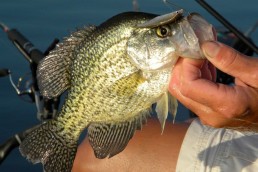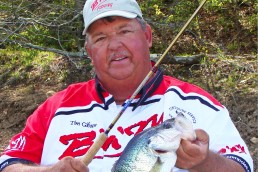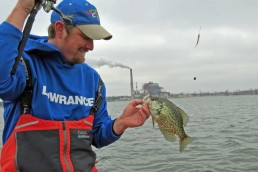Clinton Lake Crappies
SHARE THIS POST
Although there is good fishing for a variety of species in this lake, the crappies have become a bread and butter species in April and May.
This 5,000-acre, warm-water discharge lake in DeWitt County is one of Illinois’ largest state-managed lakes. Located near the town of Clinton, it is open year-round, but there are special winter angling rules. A portion of the area round the Route 54 Bridge is closed and a no-wake speed limit is in effect from one half hour after sunset to one half hour before sunrise.
Builders of the lake cleared most of the basin during construction. There are old roadways and bridges reduced to rubble and left in the lake basin. Riprap was placed along causeways and along the dam area. There are some steep banks and lake structure can be located with the aid of electronics or a good map available at local sport stores and bait shops.
This lake has an average depth of 15 feet with a maximum depth near the dam of 40 feet. The shoreline is erratic and almost 130 miles in length. Rolling hills and some steep banks are prominent on the shore too.
The warm-water discharge is a magnet for crappies. During late winter, as the passing cold fronts continued, the fish left the warm water to move to the shallows to feed. They moved into coves at a depth of 5 to 10 feet. They then return to the deeper waters at night. Prior to that and at night they relate to the deep-water structure. The old main creek channel contains some fish attractors. Minimum length for keeper crappies is 9 inches. According to IDNR, survey records the average crappie in the lake is about 10 inches in length.
Are you enjoying this post?
You can be among the first to get the latest info on where to go, what to use and how to use it!
Public boat ramps and public access points around the lake are now open.
Crappies are best when water temperatures reach the 50 to 70 degrees. Spring does bring in a succession of cold fronts and the crappies move to more shallow water each day after passage of these fronts. Then they move back to deeper water as the next front passes through.
Eventually the fish begin to spawn and spend most of their time in very shallow water. Anglers fishing both from shore and boats take many fish. Many are located in coves around stick-ups in 5 to 20 feet of water. They are fleeing the hybrid striped bass in the main lake channels.
Don Gasaway is a veteran outdoor writer from Marion, Ill. He may be contacted at: dongasaway.wordpress.com or facebook.com/DonsJournal.
MWO
SHARE THIS POST
Did you enjoy this post?
You can be among the first to get the latest info on where to go, what to use and how to use it!
Don Gasaway
Don Gasaway is a veteran freelance outdoor writer from Marion, Ill. He may also be found at: https://www.facebook.com/DonGasawayWriter and facebook.com/Wandering Angler. Comments are welcome



